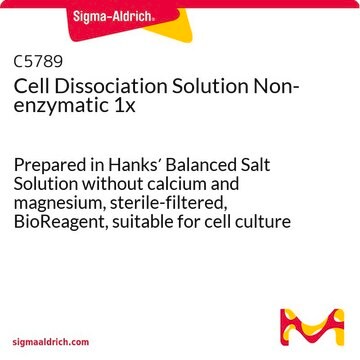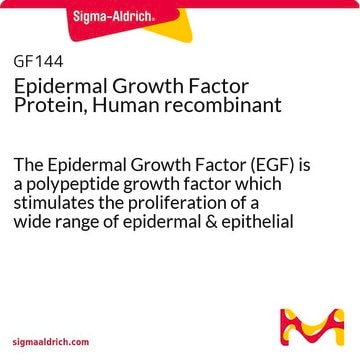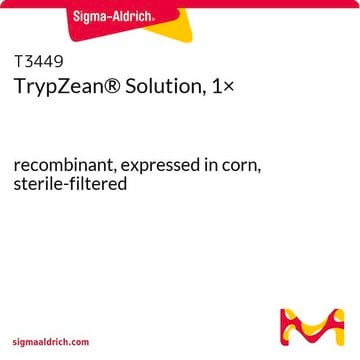Transportation information can be found in Section 14 of the product's (M)SDS.To access the shipping information for this material, use the link on the product detail page for the product.
C5914
Cell Dissociation Solution Non-enzymatic 1x
Prepared in phosphate buffered saline without calcium and magnesium, sterile-filtered, BioReagent, suitable for cell culture
Synonim(y):
Roztwór dysocjacyjny
Wybierz wielkość
391,00 zł
Wybierz wielkość
About This Item
391,00 zł
Polecane produkty
Poziom jakości
sterylność
sterile-filtered
linia produktu
BioReagent
Formularz
liquid
stężenie
1 ×
metody
cell culture | mammalian: suitable
pH
6.9-7.1
Warunki transportu
wet ice
temp. przechowywania
2-8°C
Szukasz podobnych produktów? Odwiedź Przewodnik dotyczący porównywania produktów
Opis ogólny
Zastosowanie
produkt powiązany
Kod klasy składowania
10 - Combustible liquids
Klasa zagrożenia wodnego (WGK)
WGK 3
Temperatura zapłonu (°F)
Not applicable
Temperatura zapłonu (°C)
Not applicable
Wybierz jedną z najnowszych wersji:
Masz już ten produkt?
Dokumenty związane z niedawno zakupionymi produktami zostały zamieszczone w Bibliotece dokumentów.
Klienci oglądali również te produkty
-
What is the Department of Transportation shipping information for this product?
1 answer-
Helpful?
-
-
Can one use Product C5914, Cell Dissociation Solution, with tissue?
1 answer-
We have only used with monolayer cell culture, and therefore we have no information on its usage with tissue.
Helpful?
-
-
Does Product C5914, Cell Dissociation Solution, work with epithelial cells?
1 answer-
It will work with most cell types.
Helpful?
-
-
Does Product C5914, Cell Dissociation Solution, contain EDTA?
1 answer-
Yes, it does contain EDTA; the concentration is proprietary.
Helpful?
-
-
When trypsin is used to detach cells, one usually adds fetal bovine serum (FBS) to the media. Should FBS be used with Product C5914, Cell Dissociation Solution?
1 answer-
No. FBS is used to inactivate trypsin. This product is not enzymatic, so there is no need to use FBS. The cells can be washed with phosphate buffered saline (PBS). When the cells are to be cultured, then one would need to add FBS.
Helpful?
-
Active Filters
Nasz zespół naukowców ma doświadczenie we wszystkich obszarach badań, w tym w naukach przyrodniczych, materiałoznawstwie, syntezie chemicznej, chromatografii, analityce i wielu innych dziedzinach.
Skontaktuj się z zespołem ds. pomocy technicznej












